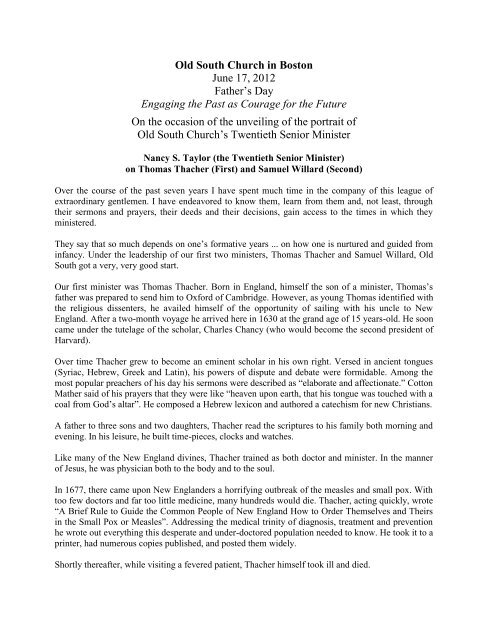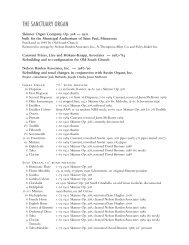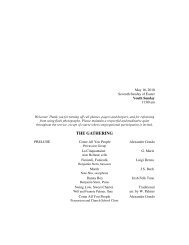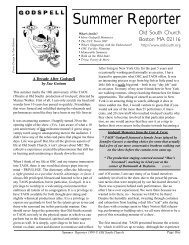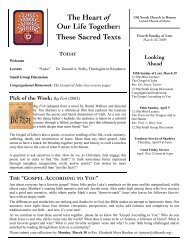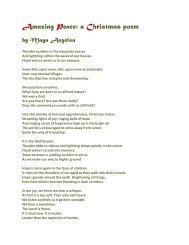You also want an ePaper? Increase the reach of your titles
YUMPU automatically turns print PDFs into web optimized ePapers that Google loves.
<strong>Old</strong> <strong>South</strong> <strong>Church</strong> in BostonJune 17, 2012Father’s DayEngaging the Past as Courage for the FutureOn the occasion of the unveiling of the portrait of<strong>Old</strong> <strong>South</strong> <strong>Church</strong>’s Twentieth Senior MinisterNancy S. Taylor (the Twentieth Senior Minister)on Thomas Thacher (First) and Samuel Willard (Second)Over the course of the past seven years I have spent much time in the company of this league ofextraordinary gentlemen. I have endeavored to know them, learn from them and, not least, throughtheir sermons and prayers, their deeds and their decisions, gain access to the times in which theyministered.They say that so much depends on one’s formative years ... on how one is nurtured and guided frominfancy. Under the leadership of our first two ministers, Thomas Thacher and Samuel Willard, <strong>Old</strong><strong>South</strong> got a very, very good start.Our first minister was Thomas Thacher. Born in England, himself the son of a minister, Thomas’sfather was prepared to send him to Oxford of Cambridge. However, as young Thomas identified withthe religious dissenters, he availed himself of the opportunity of sailing with his uncle to NewEngland. After a two-month voyage he arrived here in 1630 at the grand age of 15 years-old. He sooncame under the tutelage of the scholar, Charles Chancy (who would become the second president ofHarvard).Over time Thacher grew to become an eminent scholar in his own right. Versed in ancient tongues(Syriac, Hebrew, Greek and Latin), his powers of dispute and debate were formidable. Among themost popular preachers of his day his sermons were described as “elaborate and affectionate.” CottonMather said of his prayers that they were like “heaven upon earth, that his tongue was touched with acoal from God’s altar”. He composed a Hebrew lexicon and authored a catechism for new Christians.A father to three sons and two daughters, Thacher read the scriptures to his family both morning andevening. In his leisure, he built time-pieces, clocks and watches.Like many of the New England divines, Thacher trained as both doctor and minister. In the mannerof Jesus, he was physician both to the body and to the soul.In 1677, there came upon New Englanders a horrifying outbreak of the measles and small pox. Withtoo few doctors and far too little medicine, many hundreds would die. Thacher, acting quickly, wrote“A Brief Rule to Guide the Common People of New England How to Order Themselves and Theirsin the Small Pox or Measles”. Addressing the medical trinity of diagnosis, treatment and preventionhe wrote out everything this desperate and under-doctored population needed to know. He took it to aprinter, had numerous copies published, and posted them widely.Shortly thereafter, while visiting a fevered patient, Thacher himself took ill and died.
Among the tributes to his memory, is a Greek verse written by Eleazor, an Indian youth studying atHarvard (translated here):Though earth contains his dust, his name is yet immortal :It shall light the future ages as o’er the past it beamed :While his soul set free from prison, seeks the ever-open portalWhere the shining ones are waiting to welcome the redeemed.Thacher’s Brief Rule was the single most important publication of its day. It was published twicemore, posthumously, during subsequent epidemics.Johns Hopkins Medical School avers that Thacher’s medical broadside was the first patientinformation brochure on this soil. They count our Thomas Thacher among the important contributorsin the history of modern medicine.Our second minister, Samuel Willard, graduated Harvard in 1659. Like his predecessor, SamuelWillard was a scholar-pastor. Among the brightest clerics of his day, he wrote and published “AComplete Body of Divinity: composed of two-hundred and fifty expository lectures.” In this, thelargest tome ever published in the Colonies, often called New England’s Summa Theologica, hesummarized the faith of the Puritan fathers.Willard was serving a church in Groton, MA, when the entire town was dispersed by Indians duringKing Philip’s War. Willard and his family fled to Boston. <strong>Old</strong> <strong>South</strong> minister Thomas Thacher wasailing and they turned to Samuel Willard for help. When Mr. Thacher died shortly thereafter, Mr.Willard was appointed to the pastorate.Fourteen years into Willard’s pastorate a strange hysteria broke out 18 miles from here, in the townof Salem. Regrettably, our <strong>Church</strong> was not so far away as to escape the madness. Some of ourmembers were accused of witchcraft (including such respected personages as John Aldan and Mrs.Thacher, widow of our first minister). Others of our members were accusers. Four of our membersserved as judges in that appalling miscarriage of justice.With a keen mind and a good heart, Samuel Willard studied the phenomena and determined itsfoolishness. At the risk both of his reputation and his life, he placed himself between accused andaccuser. Employing his pastoral and learned voice, and his erudite pen, he urged New Englanders toregain their reason.He chastised the judges. He and other clergy were eventually successful in forcing the Governor todismantle the special court of Oyer and Terminer, the court established to hear “spectral evidence”.Thirty-two so-called witches were executed in New England in 1692. Thirty-two. Had it not been fora handful of courageous clergy like our Samuel Willard, many more would certainly have perished.After all, at the same time across Europe, tens of thousands were executed.Concurrent with his obligations as the Minister to this church, Willard served for six years (until hisdeath) as the acting president of Harvard. Why acting? Harvard required of its President that he livedon their side of the Charles. Willard, pastoring on this side of the Charles and well-ensconced in ourparsonage, had no intention of moving. Harvard liked him so well, however, that they kept him, but
ARCOS DESIGN – vol.5, n° 2 – Dezembro 2010ISSN 1984-5596UERJ - Universidade do Estado do Rio de JaneiroESDI - Escola Superior de Desenho IndustrialPPDESDI - Programa de Pós-Graduação em Designem virtude de uma relação diádica, de causa e efeito, com O, então ele é um índice de O. Nestecaso, S é realmente afetado por O, de modo que devem existir, como fatos, S e O. Se a relaçãoentre S e O é uma relação mediada por I, então ela é uma relação triádica. Se S está em umarelação triádica com O, envolve um terceiro termo, I, que está para O através de S. Neste caso, Sé um símbolo de O. Não há mais do que três formas de relações que podem ser estabelecidasentre um signo (e.g., uma palavra, um diagrama, uma partitura musical) e um objeto que o signorepresenta -- ou um signo é análogo ao objeto, por similaridade, ou está espaço-temporalmenteconectado ao objeto, ou deve representá-lo por meio de uma lei. A terceira tricotomia, definidapor Liszka (1996, p. 40) como o “poder interpretativo do signo”, descreve a capacidade do signode gerar um interpretante, e se divide em rema, dicente e argumento (CP 2.250). Rema é umsigno que é interpretado como um signo de “possibilidade” – “um signo de possibilidadequalitativa, ou seja, entendido como representando esta e aquela espécie de objeto possível” (CP2.250). O dicente é um signo que, para seu interpretante, é um signo de existência real, umevento ou uma ocorrência (CP 2.251). O argumento é um signo que é interpretado como umsigno de lei (CP 2.252).Estas divisões permitem observar, com enorme detalhamento, as relações entre signo, objeto einterpretante. A partir destas divisões Peirce concebe uma classificação em que as classesresultam do cruzamento das tricotomias. Os resultados das divisões podem ser combinados,seguindo certas regras, criando um sistema de relações cruzadas (ver QUEIROZ 2006). Asrelações (monádica, diádica, triádica), e a lei que permite relacioná-las, provêem a estrutura dasclassificações sígnicas, e no caso particular que mais nos interessa aqui, das dez classes signos. 3As dez combinações (classes), ou cruzamentos, baseadas em três tricotomias, que devemsatisfazer as “regras de qualificação” são: 111, 211, 221, 222, 311, 321, 322, 331, 332, 333 (verTabela 11 Para uma abordagem detalhada deste modelo, ver Savan (1987-88: 14), Queiroz (2006, 2004).Tabela 1: Dez classes de signos identificadas por Peirce.As classes estão designadas por uma notação numérica (primeira coluna)ClassesPrimeira divisão(tricotomia)Segunda divisão(tricotomia)Terceira divisão(tricotomia)111 (I) Qualisigno Ícone Remático211 (II) Sinsigno Ícone Remático221 (III) Sinsigno Índice Remático222 (IV) Sinsigno Índice Dicente311 (V) Legisigno Ícone Remático321 (VI) Legisigno Índice Remático322 (VII) Legisigno Índice Dicente331 (VIII) Legisigno Símbolo Remático332 (IX) Legisigno Símbolo Dicente333 (X) Legisigno Símbolo ArgumentoEsta é uma sumária descrição das classes: (I) 111, ou qualisigno, é uma “qualidade” que é umsigno. Ele só pode ser um ícone do objeto, e ter um rema como interpretante (CP 2.254), isto é,ser interpretado como um signo hipotético ou de possibilidade. (II) 211, ou um sinsigno icônico,é um evento particular que é um signo. Seu objeto é um ícone, que ele interpreta como umapossibilidade, ou um rema (CP 2.255). (III) 221, ou sinsigno indexical remático, é uma4/49
Prince’s collecting, and his desire to communicate knowledge, make him a scholar. He published oneof the first annotated and accurate histories anywhere—this is it, dated 1736.But Prince knew something about book collections—they die with the collector. Cotton Mather’sgreat library broke up upon his death—and indeed Prince grabbed a sizeable share of it.Prince didn’t want his own library to die with him, so he bequeathed his great collection—whichfilled the Meeting House tower that many of you climbed last November—to <strong>Old</strong> <strong>South</strong>, to be kept,as his bequest says, “entire, forever.”What a cheeky thing to do. The Junior Minister fills the tower (the traditional space of the SeniorMinister) with books and stuff and then tells the Council to keep it all there—forever! It took Councilthree years to even accept the bequest.And there the books and manuscripts sat. And sat badly.Until Joshua Huntington. This young man, ordained at <strong>Old</strong> <strong>South</strong> in 1808 (at the age of 24), had aninterest.He became Senior Minister in 1809 upon the death of Joseph Eckley. That year, he married adescendant of John Eliot, who produced the Eliot Indian Bible, a copy of which many of you saw lastyear.In 1811, a committee was voted by Council to look into the state of affairs of the Prince’s bookishmess in the tower. That committee found the Library “in a very ruinous situation, laying about thefloor, trodden over and cover’d with dust.”So Huntington took it all in, personally, to his house, where shelves and cases were made for thecontents.Huntington then made an agreement with the Historical Society to take over the strictly historicalpart of the library for safekeeping and scholarship there. And he oversaw the creation of the firstcatalog of the works that were still in his house.Indeed, Huntington’s interest in history and our documents was so keen that the Historical Societyelected him Resident Member in 1816. A position he turned down, for by then he was battlingrheumatic fever, which killed him at age 35.Prince is the famous one. The bookish one, railing against modern church music, opining on thetheological roots of earthquakes and lightning, and generally seeming to play the aging, somewhatwealthy highbrow scholar against his more accessible, perhaps more avuncular and certainly nonscholarly,Senior Minister Joseph Sewell.Huntington didn’t leave such a legacy (Huntington Avenue is named for his father, one ofWashington’s generals). He just wasn’t around long enough. In the history of <strong>Old</strong> <strong>South</strong>, he comesthrough as a young and energetic preacher to the disadvantaged, perhaps reflecting the tradition ofJohn Eliot, with the help of his wife, Eliot’s kin.
Anyhow, he just died too young to have made much more of a record. But he saved the PrinceLibrary. It sat as a cataloged, organized whole until Rev. Manning invited the City of Boston to takecare of it—which is where it is today. A treasure that every book scholar knows. The jewel of thecollections at the Boston Public Library. A treasure belonging to you, the members of thecongregation.Prince would have been profoundly grateful that this young man Huntington preserved his greatlegacy to his church and the nation.James W. Crawford (Nineteenth) onJacob M. Manning (Fifteenth) and George A. Gordon (Sixteenth)When he left for the front to serve as chaplain with the Forty Third Regiment of MassachusettsVolunteers in October 1862, Jacob Manning delivered a sermon to the regiment asserting, “Freedomhas at length come to this western world and taken her proud seat among nations. Verily, it is a grandand awful trust which the generations have committed to our keeping …” He entitled that regimentalsermon: “The Soldier of Freedom.”The Soldier of Freedom: <strong>Old</strong> <strong>South</strong> claims such a soldier in Jacob Merrill Manning. He fought forfreedom for the Union not only in North Carolina, but, ironically, within the precincts of none otherthan the <strong>Old</strong> <strong>South</strong> Meeting House. You see, Jacob Manning found himself yoked in joint ministrywith George Washington Blagden from 1857 to 1872. George Blagden outranked Manning by 21years of Meeting House experience; he swaggered around, fully aware of his seniority, flaunting hispedigree from Washington, D.C., thus, during the Civil War diffusing his affinity with theConfederate cause, clearly evincing an identity known in these climes as: “Copperhead.” A historianof later vintage reflecting on their joint ministry claimed that Manning and Blagden “walked togetherin simplicity and Godly sincerity, labored side by side with mutual helpfulness as few colleaguesthrough such trying and exciting time ever have done.” Sounds great doesn’t it? Don’t you believe it.The vitriol seethed between them, the younger Manning accusing Blagden of “rude treatment,”acting as a “scolding pastor.” He castigates his elder colleague as disloyal, and begs this congregationto “scorn the flattery of traitors.” Manning harbors incredulity as Blagden votes against Lincoln; hecomments acerbically on Blagden’s refusal to read Lincoln’s Thanksgiving proclamations. When theConfederacy surrenders in April 1865 Manning tells us Blagden’s Confederate sympathies nearlydrove congregants from the house. The bitter tension explodes at Lincoln’s death. Writing in hisjournal two days after that Good Friday assassination, having preached on Lincoln’s murder that veryEaster morning, Manning describes the whole nation as inconsolable and weeping; then, in fury, hecontinues, “… Not finding our church draped in black, as it should have been, I ordered the sexton tothrow my ‘copperhead’ associate’s gown over the reading desk, and I put the Bible on that. So thePresident’s funeral sermon was preached lying on (Blagden’s gown), though he himself feels littlesorrow at our woeful loss.”Jacob Manning, then: our Solider of Freedom sustaining that “grand and awful trust the generationshave committed to our keeping.”Our soldier of freedom named his daughter Susan Huntington and she married, guess who?, hissuccessor, George Angier Gordon.
I hold in my hand here a book from among many written by George Gordon. The title? “The Christof Today … The Christ of Today.”George Gordon represents rare intellectual, spiritual and cultural creativity. He served thiscongregation, this city and our world from 1884 until 1927 – 43 years. He proved a lynchpin betweenan era of hard core, New England, Calvinistic doctrine demanded of all ministerial candidates and amodern, progressive, approach to thinking, perceiving and articulating the faith this congregationcherishes to this day. George Gordon believed passionately in his time, God still speaks.The fiery encounter between the old and the new took place in this building on April 2, 1884.Gordon, arriving in Boston the day before – April Fool’s Day – confronted ministers and lay-peoplefrom the region in what we call an Ecclesiastical Council, they, testing his theological competence,verifying his adherence to a rigid Biblical fundamentalism in a centuries old doctrinal framework.So, what happened? To put it mildly, George Gordon shocked that Council. First of all, <strong>Old</strong> <strong>South</strong>’sCouncil invitations excluded the customary warrant privileging Council’s members to eveninterrogate Gordon. This church considered such questioning a usurpation of our Congregationalindependence in calling and installing whomever we chose. <strong>Old</strong> <strong>South</strong>’s perceived insolence, ofcourse, infuriated Council members and they organized cabals preparing to grill Gordon to an inch ofhis life and send him back to Greenwich, Connecticut from whence he came. In addition hecomposed and offered a personal confession of faith, refusing to surrender his mind and heart to thetheological war horse of Reformed Orthodoxy, The Westminster Confession of 1649. As aconsequence, the Council challenged his pastoral legitimacy. Moreover they ceaselessly badgeredhim with scores of hostile queries seeking to prove him a heretic. After hours of cross-examinationthe Council retired to debate the matter, while a large crowd of religious and ecumenical VIPsassembled, anticipating, at some point, a greeting from their neighbor across the street, PhillipsBrooks. Brooks did appear, but that expectant company, waiting impatiently for the absent Council,partook the delicious collation prepared for them, the returning Council interrupting dessert,approving Gordon’s ministry by a count of 48 to 18, chagrined, of course, their supper missed.Angered, a number of Council members abandoned the installation ceremonies, the preacher himselfabsconded, and William Jewett Tucker, a venerable Andover Liberal, eventually President ofDartmouth College, delivered the sermon.Dr. Gordon later reflected on that truculent, game-changing Council, recalling the story of a youngman experiencing a similar ordeal. Gordon writes: after an extended and severe inquisition, “rangingall the way from the eternal purposes of God to the bliss of the righteous and woe of the wicked inthe world to come, the exhausted candidate was asked if he were willing to be damned for the gloryof God. His answer was that he was not willing to be damned for the Glory of God, but if it were forthe Glory of God that this Ecclesiastical Council be damned, he would in no way raise anyobjection.”Friends: remember that vote: 48 to 18: then, God be praised, 43 years in this nave awash with: “TheChrist of Today.”Peter H. Meek on his father,Frederick M. Meek (Eighteenth)Fred Meek arrived at <strong>Old</strong> <strong>South</strong> from Plymouth <strong>Church</strong> in Des Moines in the fall of 1946. The worldwas beginning to pick up the pieces following World War II; and one of my earliest memories was
helping him to put up, in our basement family room, posters that he’d acquired somewhere,announcing the Marshall Plan. Europe would be rebuilt in what he rightly celebrated as anunprecedented act of national generosity and responsibility.That afternoon in the basement remains for me an important symbol of his ministry: he was alwaysengaged with the world, and laboring towards a strong Christian presence in public affairs.He had a dignified and rather reserved public self – people expected that of the clergy back then. Itwould come as a surprise to many who knew him that he was an idealist. Racial justice mattered tohim long before the Civil Rights era. He was an internationalist in his view of the world. He was aconservative in many ways; tradition and custom mattered a lot and were reflected in the style ofworship here. But he had the heart of a liberal, sometimes to the surprise and even the distress ofsome folk in the congregation. He was deeply committed to what we would now call, I imagine,“mainline Christianity”. The postwar years were a time of full pews just about everywhere, but it wasclear to him that American religiosity as it appeared in the fifties and early sixties was certainlybroad, but its lack of depth concerned him. His preaching was always and deliberately scriptural, andfor him faith was at life’s core. The title of his first book puts it well: “Monday to Friday Is NotEnough”.He preached powerful sermons on the occasions of the assassinations of President Kennedy and Dr.King. The sermon he preached after the events in Dallas was telecast nationally, and was deliveredfrom the pulpit of the <strong>Old</strong> <strong>South</strong> Meeting house – yes, he started that tradition. He spoke among otherthings to the issue of firearm violence in American society; and measured his success, with greatenjoyment, by the sacks, literally sacks, of hate mail that arrived at <strong>Old</strong> <strong>South</strong>’s doors.He had things to say from this pulpit while Joseph McCarthy blighted American politics andAmerican society. This was brought to the attention of the FBI, who sent agents to hear thissubversive preacher. He relished telling the story of how three of the agents became <strong>Old</strong> <strong>South</strong>members.For many reasons, he had little knowledge of or appreciation for Roman Catholicism. But God sawto it that he and Richard Cardinal Cushing became close friends, and Fred Meek became a leader inecumenical Christianity in, and also far beyond, Boston. That friendship meant a great deal to himand in mid-life it changed him, deeply.Through nearly three decades, Fred Meek was a faithful Christian, a light to the city, and proud to benumbered among the company of <strong>Old</strong> <strong>South</strong> ministers whom we celebrate this Sabbath day.Guilliaem Aertsen, former Trustee, onJames W. Crawford (Nineteenth)To appreciate why Jim Crawford’s ministry mattered and what was at stake, historical perspective isimportant.Jim’s ministry from 1974-2002 spanned a period of enormous social, cultural, political and economicchange. Many institutions without strong leadership declined or were swept away.So what was going on?
These were the post Watergate/Vietnam war years which had generated deep divisions in our society,and a distrust of leadership generally. There were seismic demographic changes underway – the babyboomers were coming of age, questioning everything and demanding new ways. Middle classfamilies were fleeing urban centers, away from crime, homelessness, an affordable housing crisis andcrumbling infrastructure for a better life in the suburbs. In churches, attendance in traditionalprotestant congregations was declining. The sexual revolution was in high gear. Schooldesegregation, busing and an end to school prayer were changing the face of public schools,particularly in Boston. The rise of OPEC and inflation were destabilizing economies. The internetwould begin to transform everything. Crimes against humanity made far off places like Somalia alltoo real. Terrorism became the new normal.I’m sure new ministers to urban churches in the early 70’s didn’t know what they had bargained for,but certainly, looking back, survival for many was at stake.Arriving in the spring of 1974, Jim wrote his first of almost 1,500 <strong>Old</strong> <strong>South</strong> sermons. In them, hewould define a public theology around these issues – a moral compass to navigate. Jim’s sermonslinked the church calendar, a lesson from the bible and a current event – and then provided guidanceand direction. And always a wonderful musical program would go with it. And when words weren’tenough—as during Boston’s school busing crisis—Jim was out there with the students riding thebuses.Imagine the cumulative effect of these sermons on all of us as we went out into the world to do ourthing. Read Jim’s book, Worthy to Raise Issues. It’s all there.Then there were the legacy decisions that really mattered: The decision to restore our church buildinginside and out—not just to fix and patch the leaks as so many churches did—but to truly bring ourbuilding back to its original glory was a 100 year investment. And then to double down and savefrom demolition an irreplaceable American treasure, our Skinner organ, knowing that it wouldbecome the cherished center of our music program. Magnificent!The decision made by the New Century Hymnal Committee, which Jim chaired, to adopt anapproach to use inclusive language throughout and yet maintain the theology and beauty of theoriginal text without its bias was transformational. The UCC obviously chose wisely to find as itschair someone with a deep intellectual grasp of history, culture and music – a rare combination at anytime.Then came the critical decisions as we went through our financial reorganization which allowed us toreshape our priorities for the future – stronger, better, wiser.Finally through all of this, keeping an open house and a welcoming congregation available foroutreach groups to assemble, committees to meet and children to learn was our lifeline.The outcome at <strong>Old</strong> <strong>South</strong> by 2002 could have been much different without Jim’s hand at the helm –but here we are today, all the better for his leadership efforts.Yogi Berra was famous for saying: “when you get to that fork in the road – take it.” Not exactly aformula for finding your way in the world.
Jim Crawford’s compass works much better.Pamela Roberts, former Moderator, onNancy S. Taylor (Twentieth)Nancy, you burst on the scene at the Massachusetts United <strong>Church</strong> of Christ’s annual meeting in June2001, when the Search Committee presented you to the delegates as their choice to lead ourCommonwealth’s churches. Already nationally known for your commitment to social justice issues,as well as for your strong voice from the pulpit, you blew us away with your vision of a faith thatwas based on, in your words, Jesus’ radical love and inclusion. You challenged us to spin our ownwebs of love, with which to catch souls hungry for the GOOD news of Jesus Christ.To THIS congregation’s great fortune, you said “yes” when <strong>Old</strong> <strong>South</strong> called you as its new SeniorMinister and CEO in 2005. How befitting that you would come to a place with the words, “Behold Ihave set before thee an open door,” carved in stone over the portico. You have set quite the tone,challenging us time and again to be the bearers of the banner that states “There’s a wideness in God’sMercy, like the wideness of the sea; there’s a kindness in God’s justice, which is more than liberty.”As we unveil your portrait today, Nancy, our first female senior minister, I am reminded of howwomen have always been a part of this church’s story, and keep on making history here. I think aboutthose present, those watching from afar, and those who have laid the groundwork:I speak for Mary Norton, who in 1669 gave land to a group of church dissenters upon which to builda new church, a church that had a radical idea about inclusion and God’s grace.I speak for Phillis Wheatley, formerly enslaved, <strong>Old</strong> <strong>South</strong> member, and author of the first book ofpoetry written by a black American woman in 1773.I speak for Catherine Dauber, Elsbeth Percy, and Doreen Spence Siddall, my three predecessors asfemale moderators. I just know that Catherine and Elsbeth are tickled pink in heaven today.I speak for the Reverend Dr. Arlene Nehring, who conceived of a Christian fellowship for lesbiansand gay men where there was none.I speak for Diane Gaucher, who, as Senior Deacon, was one who pushed to have this portrait done –a big undertaking, as you don’t take kindly to sitting still.I speak for Jan Monsma, who rejoices that the glass at <strong>Old</strong> <strong>South</strong> <strong>Church</strong> is in beautiful windows,and not on any glass ceiling.And finally, I speak for my daughter Miranda, who will grow up thinking it commonplace for awoman to be senior minister of a large, vibrant urban church.This beautiful, graceful portrait is but two-dimensional — YOU are so much more than that. Nancy,today we celebrate YOU: our spiritual guide, our social justice conscience, our spinner of big, websof love.


